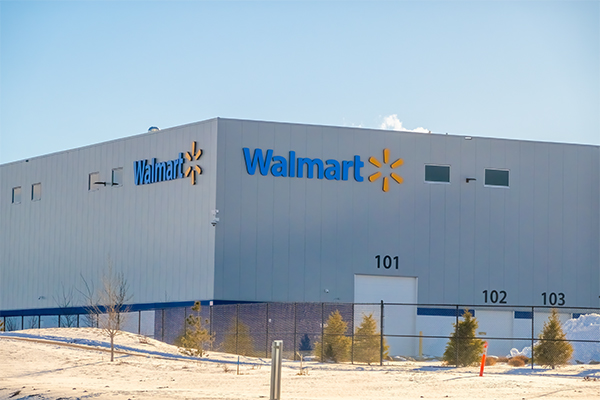Walmart’s vast and complex supply chain is one of the largest in the world. From sourcing raw materials to delivering goods to customers, the company moves millions of products daily across a global network. What sets Walmart apart is not just the scale but how they have used advanced automated solutions and optimization to streamline operations and reduce costs.
But Walmart’s secret to success is not just for large enterprises. Small and medium-sized retailers can take cues from the way the company runs its supply chain, adopting similar practices to enhance their own efficiency.
Let us dive into how Walmart’s supply chain operates and how you can implement similar strategies.
Walmart’s supply chain: a global powerhouse of efficiency
At the heart of Walmart’s success is its supply chain, which includes over 150 distribution centers around the world, hundreds of transportation hubs, and a network of suppliers.
Walmart’s supply chain is designed to move products quickly and efficiently from manufacturers to stores and customers, ensuring that shelves are stocked and online orders are delivered on time.
What makes this retailer’s supply chain stand out is its reliance on lean manufacturing principles and its ability to automate processes to reduce inefficiencies.
Lean manufacturing involves minimizing waste while maintaining product quality. In Walmart’s case, this means reducing excess inventory, cutting down on unnecessary movement within warehouses and ensuring faster product turnover.
But how does Walmart achieve such high levels of efficiency in such a massive operation?
The Role Of Technology In Walmart’s Supply Chain
Technology and innovation play a crucial role in Walmart’s ability to scale its operations and manage the flow of products efficiently. Over the years, Walmart has heavily invested in software solutions to automate key processes in its supply chain, from order picking to inventory tracking. These technologies are designed to speed up processes, reduce human error, and cut operational costs.
One of Walmart’s most significant advancements in automation came with the use of Autonomous Mobile Robots (AMRs) as part of its system.
Walmart leverages AMRs to streamline the retrieval, sorting, and movement of products. These robots autonomously navigate warehouse floors, handling items with speed and efficiency that surpasses human capability.
For Walmart, this integration means faster order fulfillment, fewer errors, and lower labor costs. AMRs play a key role in reducing the time it takes to pick and pack products, helping Walmart ship orders more quickly and maintain high levels of efficiency.
According to McKinsey, companies investing in warehouse solutions, including robotics and warehouse management systems, can achieve productivity improvements of 20-40% within a few years and reduce labor costs significantly through optimized operations.i For Walmart, these automated systems are not only for saving time—they are about ensuring that customers get the right products on time, every time.
Inventory Optimization: Walmart’s Secret To Staying Ahead
Walmart’s massive supply chain also relies on inventory optimization to ensure that products are always available when customers need them. Inventory optimization is the process of using data to make sure the right amount of stock is always available—neither too much nor too little.
For Walmart, this is achieved through a combination of predictive analytics and real-time data.
Walmart uses advanced forecasting tools to predict customer demand based on historical sales data, seasonal trends, and market shifts. By analyzing these data points, Walmart can adjust its inventory levels in real time, ensuring that popular items are always in stock while avoiding overstocking slow-moving products.
But inventory optimization is not only about forecasting demand. It is also about supply chain visibility—knowing where every product is at all times.
Walmart uses sophisticated tracking systems to monitor the movement of goods from the supplier to the customer. These systems allow Walmart to respond quickly to changes in demand, such as during busy holiday seasons like Black Friday or special promotions, ensuring that inventory levels are always aligned with customer needs.
One of the reasons Walmart excels in this area is its use of vendor-managed inventory (VMI). In VMI, Walmart shares its sales data with suppliers, who then take responsibility for managing their own inventory within Walmart’s distribution centers. This collaborative approach reduces the risk of stockouts and ensures that products move quickly through the supply chain.
What Retailers Can Learn From Walmart’s Supply Chain
While Walmart operates on a large scale, many of the strategies they use can be applied by smaller retailers and wholesalers to optimize their own supply chains.
The key is focusing on technology and optimization in manageable steps, allowing you to gradually improve your warehouse operations without needing Walmart’s level of resources.
Here are a few lessons smaller retailers can learn from Walmart’s approach:
- Start with technological solutions: Like Walmart, retailers can introduce automation in high-impact areas. For example, using automated picking systems or AMRs can reduce the time it takes to fulfill orders, improve accuracy, and lower labor costs. You do not need to automate everything at once start small and scale up as your business grows.
- Optimize inventory levels: Smaller retailers can also benefit from adopting real-time inventory tracking and forecasting tools. A WMS like Körber’s allows businesses to monitor inventory levels in real-time, ensuring that popular items are always available while avoiding the costs of overstocking.
- Leverage data for decision making: Walmart’s ability to predict demand is powered by data, and smaller retailers can do the same by integrating data analytics into their supply chain operations. Körber’s WMS offers analytics tools that help businesses make informed decisions based on real-time data, improving order accuracy and customer satisfaction.
Case Study: How Körber’s WMS And Flexible AMR Solution Helped Ariat Improve Efficiency And Employee Satisfaction
To illustrate how retailers can leverage autonomous mobile robots and optimization like Walmart, let us look at Ariat International , a performance footwear and clothing brand facing challenges in managing increasing order volumes and maintaining accuracy in their manual warehouse operations. Different technologies and levels of technology were used throughout the facilities, making it cumbersome to adapt to their customer needs.
By partnering with Körber Supply Chain Software and implementing their WMS and Autonomous Mobile Robots (AMR) solutions, Ariat experienced significant improvements in operational efficiency.
Less than a year after rolling out Korber’s WMS, Ariat experienced increased demand in eCommerce. Meanwhile, the later addition of AMRs decreased the walking time of employees by 82% and increased accuracy and productivity.
As a result of the new system, Ariat saw reduced physical associate demand – decreased steps from 40,000 steps a day to 7,000 steps a day, increased picking accuracy and simplified training process for staff.
The Future Of Walmart’s Supply Chain: AI and Robotics
While Walmart has already made significant strides in automating its supply chain, the future of warehousing across the industry points toward even more radical transformations. Reports from industry sources like PwC and McKinsey suggest that large-scale retailers, including Walmart, will increasingly rely on technologies like artificial intelligence (AI) and robotics to streamline operations further. ii iii
For example, these reports predict that we will see a rise in fully autonomous warehouses, where robots handle everything from receiving shipments to packing and shipping orders with minimal human intervention.
AI-driven algorithms will likely play a significant role in optimizing inventory management, predicting customer demand with greater accuracy, and ensuring products move seamlessly through supply chains.
For smaller retailers and wholesalers, the future is just as promising.
Körber Supply Chain Software’s WMS already integrates with AI tools that help businesses forecast demand, manage inventory, and optimize warehouse operations. As AI and robotics become more accessible, retailers will be able to adopt these technologies to further enhance their supply chain operations and stay competitive.
Conclusion: Achieving Walmart-Level Efficiency In Your Retail Business
Walmart’s supply chain is a masterclass in automation and optimization, demonstrating how technology can streamline operations and improve customer satisfaction. But while Walmart operates on a global scale, many of the strategies it uses can be adapted for other retailers of any size.
By focusing on automated solutions, optimizing inventory and leveraging data-driven insights, smaller retailers can improve their efficiency, reduce costs and meet customer demands with greater accuracy.
With the right tools, such as Körber Supply Chain Software’s WMS and AMR solutions, smaller retailers can take the first step towards transforming their warehouse operations—just like Walmart.
Ready to optimize your supply chain? Discover how Körber’s WMS and AMR solutions can help your retail business achieve Walmart-level efficiency and stay ahead of the competition.
References:
i– Mckinsey: optimizing warehouse automation for retailers (December 27, 2021)
ii– McKinsey: Digital Logictics and The Technology Race (November 16, 2023)
iii– McKinsey: Improving Warehouse Operations – Digitally




